-
-
Access Free Student Software
Ansys empowers the next generation of engineers
Students get free access to world-class simulation software.
-
Connect with Ansys Now!
Design your future
Connect with Ansys to explore how simulation can power your next breakthrough.
Countries & Regions
Free Trials
Products & Services
Learn
About
Back
Products & Services
Back
Learn
Ansys empowers the next generation of engineers
Students get free access to world-class simulation software.
Back
About
Design your future
Connect with Ansys to explore how simulation can power your next breakthrough.
Free Trials
ANSYS BLOG
April 18, 2024
Powering Afloat: HelioRec Harnesses Solar Energy on the Sea with Simulation-driven, Optimized Design
As companies around the world pledge to reduce carbon emissions, engineers and researchers are constantly on the lookout for innovative technologies to maximize renewable energy resources. According to the U.S. Department of Energy, the amount of sunlight that hits the Earth’s surface in just an hour and a half is enough solar energy to power the entire world’s energy consumption for a year. With that much power, it’s not surprising that solar energy is one of the most promising renewable energy solutions in the world. However, solar panels usually require a large amount of vacant land, which many regions cannot offer.
To harness the power of the sun despite land limitations, French startup HelioRec — a pioneer in renewable energy solutions and member of the Ansys Startup Program — is developing floating solar technology that can be placed on bodies of water in near-shore locations.
The success of floating solar technology relies on its ability to withstand various environmental loads such as winds, waves, and currents, as well as operational factors like mooring line design. To ensure the structural integrity and optimal performance of these systems, HelioRec integrates Ansys simulation for meticulous design optimization, including advanced finite element analysis (FEA), computational fluid dynamics (CFD), and material selection. The optimized workflow empowers HelioRec to advance solar energy technology at an accelerated pace, expand its operations, and support worldwide sustainable energy initiatives.
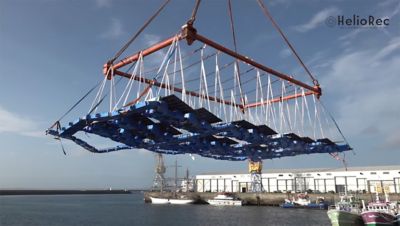
French startup HelioRec develops innovative floating solar panel technology for near-shore locations using Ansys simulation.
Maximizing Solar Energy on the Sea
Floating solar panels not only facilitate solar energy technology in areas that otherwise could not accommodate it, but also increase solar panel efficiency due to a water-cooling effect. Temperature plays a key role in the photovoltaic (PV) conversion process, with solar cell performance decreasing as temperature rises. As a result, both the electrical efficiency and power output of a solar panel depend linearly on its operating temperature. One study found that the relative annual average output energy is about 13% higher at sea compared with land, increasing up to 18% higher energy yield during some months.
Floating solar power plants utilize water bodies such as lakes, reservoirs, and ponds as platforms for solar panels. This approach offers several advantages over conventional land-based solar installations, including enhanced efficiency, conservation of land resources, and potential synergies with existing hydroelectric infrastructure. Moreover, these installations can mitigate issues associated with land acquisition and provide an environmentally friendly alternative for energy production.
Another bonus is that floating solar panel systems do not depend on the grid and therefore provide an independent source of energy.
As mentioned, floating solar technology needs to withstand environmental loads and operational factors. The finite element method (FEM) enables engineers to simulate and analyze structural behavior under different loading conditions, aiding in the optimization of material usage and structural design. On the other hand, CFD facilitates the assessment of hydrodynamic forces acting on the floating platforms, including wave-induced motions and wind loads. By combining FEM and CFD, engineers can refine design parameters to enhance the stability, durability, and energy output of floating solar installations.
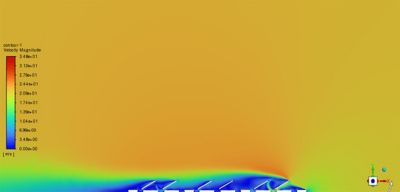
A static wind load simulation for multiple floaters with 30-degree tilt is illustrated in Ansys Fluent.
In late 2022, the 4CAD Group, an Ansys Elite Channel Partner, introduced HelioRec to the Ansys Startup Program, which enables early-to-mid-stage startups by offering affordable access to Ansys’ multiphysics simulation solutions and support.
Since then, HelioRec has conducted extensive simulations to optimize the design of its floating solar platforms, ensuring robustness against environmental loads while maximizing energy yield.
“Ansys, a leading provider of engineering simulation software, offers a comprehensive suite of tools tailored for FEM and CFD analysis,” says Polina Vasilenko, founder and chief executive officer of HelioRec. “Its advanced capabilities enable engineers to simulate complex phenomena accurately, facilitating the optimization of designs across various industries, including renewable energy.”
Understanding the Technology
There are six fundamental system components to standard floating solar panel technology:
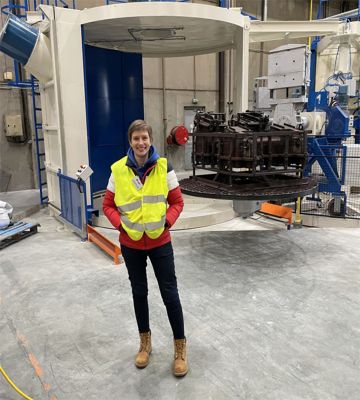
Polina Vasilenko, founder and chief executive officer of HelioRec
- PV system: PV solar panels
- Floatation system: buoyant structure and material
- Cable system: cables that connect to the electrical balance of systems (BOS)
- Platform and racking systems: the foundation for the solar panels
- Mooring and anchorage system: to secure and fix your system in place
- Electrical BOS: contains additional equipment, including a solar invertor that converts direct current (DC) electricity into alternating current (AC) electricity
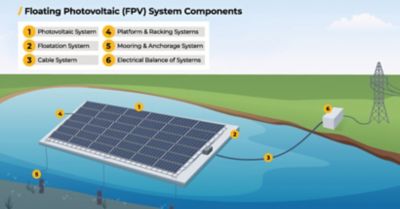
There are six fundamental system components to floating photovoltaic (FPV) technology. Image adapted from the U.S. Department of Energy.
Typically, there are also footpaths between sets of the PV panels so engineers and other team members can walk on the equipment to access the panels and other components.
In addition to the fundamentals, HelioRec’s power plants offer three innovative features, including a unique design, circular economy approach using recycled plastic, and machine learning (ML) algorithms, which help predict energy production, optimize operational maintenance, and conduct system optimization.
Let’s learn more about how HelioRec’s technology works and how simulation ensures its success.

Basic sketches depict HelioRec’s design for a typical solar panel setup, including a floatation system, FPV technology, and mooring lines.
Simulating to Harness Solar Energy
With FEA in Ansys Mechanical, HelioRec engineers fine-tune the structural configuration of the floating platforms, optimizing material selection and layout to withstand dynamic loads effectively. Mechanical is a dynamic environment that has a complete range of analysis tools, from preparing geometry for analysis to connecting additional physics for even greater fidelity. The intuitive and customizable user interface enables engineers of all levels to get answers fast and with confidence.
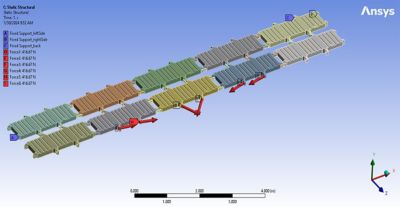
A stress analysis is performed in Ansys Mechanical on the ears of the footpath structure’s connection with the mooring line.
In connection, they use Ansys Granta Selector to enhance material selection with MaterialUniverse, a built-in comprehensive dataset that includes technical, economic, and environmental information for thousands of engineering materials. In addition, Granta Selector’s systematic materials selection methods enable engineers to compare, visualize, and set limits on properties.
HelioRec uses flexible material and a unique design of the connectors between floating elements. The combination reduces mechanical stresses on the system as a whole. Keeping an air gap between the solar panel and floater activates a passive cooling system, which supports a more efficient power plant. It also increases the natural water cooling effect.
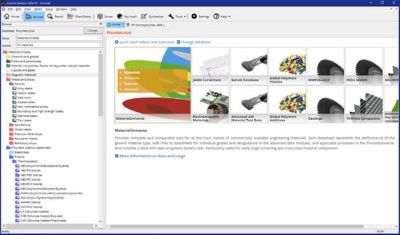
HelioRec uses Ansys Granta Selector to determine the most sustainable and durable material for its floating photovoltaic (FPV) technology.
In addition, its patented hydro-lock feature is designed to keep water inside the floater because water provides additional mass, which adds stability without the extra cost of ballast materials such as metal or concrete.
Ansys Fluent offers a modern, user-friendly interface that streamlines the CFD process from pre- to post-processing.
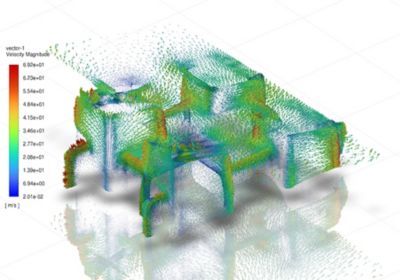
A simulation in Fluent shows a flow passing around the floater and the panel.
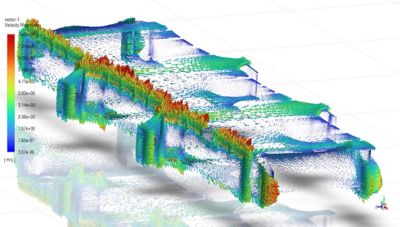
A flow simulation in Fluent models the footpath to check its drag when submerged under the water.
CFD simulations provide HelioRec with critical insight into hydrodynamic behavior, which guides the refinement of mooring line designs and platform stability.
With an accelerated workflow, HelioRec was able to move its manufacturing operation from Estonia to France and establish a new production facility. To date, the team has two floating solar panel power plant installations in operation and three in progress.
“The utilization of Ansys software empowered HelioRec to achieve unprecedented levels of design optimization, leading to the establishment of a new production facility in France,” says Vasilenko.
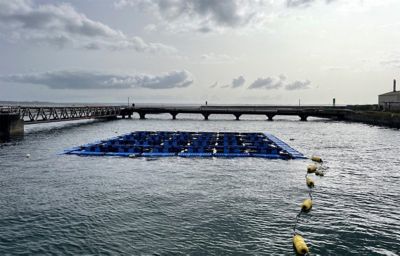
HelioRec’s floating solar power plant in the port of Brest, France.
More Solar Success on the Horizon
With refined designs and enhanced operational efficiency, HelioRec plans to make significant contributions to the global renewable energy landscape.
Design optimization of floating solar technology is crucial for unlocking its full potential as a sustainable energy solution. Through the integration of simulation, HelioRec will continue to optimize its designs and advance solar energy to support a greener and more sustainable future.
To learn how Ansys can support your early-to-mid-stage business, visit the Ansys Startup Program.